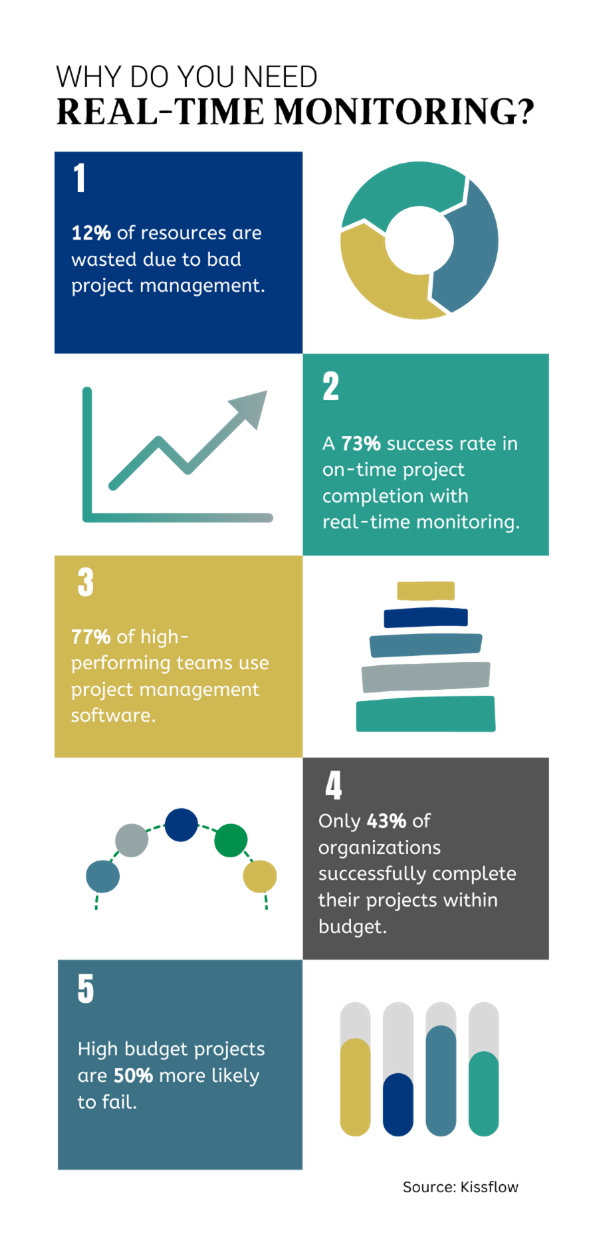
A sobering statistic hangs heavy in the air - in a PwC study of over 10,640 projects, a mere 2.5% of companies achieved complete success. The remaining 97.5% stumbled, falling short of their budget, timeline, or scope goals. Does this have to be the norm? Can you envision a project landscape where budgets are not overblown surprises but predictable outcomes? Where roadblocks are identified before they become craters, and teams adapt with the agility of Olympic sprinters?
This statistic highlights the importance of effective project management, which includes real-time monitoring and control. Real-time monitoring in project management refers to continuously tracking project progress, identifying bottlenecks, and making informed decisions based on current data. With the help of digital solutions and real-time monitoring technologies, project managers can enhance visibility, efficiency, and decision-making capabilities. This article covers the concept of real-time monitoring in project management, its benefits, and how organizations can implement it to improve project outcomes. The article also discusses innovative predictive project management solutions that provide predictive and real-time monitoring insights.
What is Real-Time Monitoring? 
Real-time monitoring is an ongoing process that captures data from various sources to provide instant insights into project progress. This data may include budget status, resource allocation, and risk metrics, all presented within a comprehensive dashboard. This continuous flow of information allows for quick responses to unexpected developments, keeping projects aligned with predefined timelines, budgets, and goals.
Real-time monitoring in IT often involves tracking system performance, network health, and application functionality. Teams use this data to monitor system integrity, troubleshoot potential issues, and optimize performance, ensuring an uninterrupted user experience and safeguarding network security.
Why Is Real-Time Monitoring Important?
Real-time monitoring is more than a process—it’s a strategic asset that provides value across multiple facets of project management. Here are several key advantages:
- Improved Project Visibility - Real-time monitoring offers an up-to-the-minute snapshot of project status, empowering stakeholders to make informed decisions.
- Proactive Risk Mitigation - Project managers can identify and address issues early by tracking project KPIs continuously, preventing potential disruptions.
- Effective Budget Management - Continuous financial tracking allows for quick adjustments, reducing the risk of budget overruns and ensuring that resources are spent efficiently.
- Resource Optimization - Real-time data on resource allocation allows for optimal distribution, reducing idle time and maximizing productivity.
- Quality Control - Monitoring quality indicators in real-time helps teams adhere to project standards, identifying deviations early and ensuring high-quality deliverables.
- Enhanced Stakeholder Communication - Real-time data promotes transparency by keeping everyone informed, thereby increasing stakeholder trust and engagement.
Steps for Building a Real-Time Monitoring Report
After the project plan and schedule receive approval, the project manager progresses to the execution phase, closely aligning with real-time monitoring to ensure compliance with the schedule and budget. Below are the steps project managers can take to embed real-time monitoring into the project lifecycle:
- Define Project Scope Baseline - Establish clear objectives, stakeholder expectations, and deliverables. A scope baseline offers a reliable reference for assessing project deviations and monitoring progress.
- Set a Schedule Baseline - Develop and approve a project timeline, then monitor actual progress against this schedule to ensure alignment.
- Establish a Budget Baseline - Accurate cost estimation sets a clear financial framework. Real-time budget tracking prevents budget creep and enables timely corrective action.
- Create a Risk Log - Identify potential risks during project planning and monitor them throughout the project’s lifecycle. This proactive approach allows for swift adjustments when risks materialize.
- Maintain a Change Log - Track all project modifications to ensure that scope, budget, or schedule adjustments are effectively managed and communicated.
- Implement Quality Assurance Protocols - Continuous quality monitoring ensures adherence to established standards and minimizes rework.
- Adopt Monitoring Tools - Utilize project management software that supports real-time tracking through dashboards, resource management, and report generation.
By integrating these steps and focusing on real-time monitoring, project managers ensure effective execution and control throughout the project lifecycle.
(The graphic below illustrates the projected market growth for predictive analytics by 2030 based on information available at Fortune Business Insights.)

Most Common Types of Real-time Monitoring Project Reports
Project management involves many tasks, and one of the most crucial is monitoring the project’s progress in real-time. These methods involve detailed customization, integration with predictive analytics, and leveraging data for continuous process improvement. To fully unlock the potential of real-time monitoring, project managers must integrate a few advanced strategies that go beyond basic implementation.
Customizing Monitoring Dashboards for Role-Specific Insights
A one-size-fits-all dashboard doesn’t cater to the unique needs of various stakeholders. Customizable dashboards are crucial as they allow specific team members, executives, and clients to access relevant insights without sifting through extraneous data. Project managers can create tailored views focused on KPIs, budget variances, or quality metrics, while executives may prefer a high-level view of project timelines and budget adherence. Custom dashboards streamline data access, ensuring that stakeholders can swiftly find and act on relevant information, thus boosting decision-making efficiency and transparency.
Integration with Predictive Analytics Tools
Predictive analytics transforms real-time monitoring from a reactive tool to a proactive strategic asset. By integrating predictive analytics, teams can anticipate project hurdles before they manifest, based on historical and real-time data. For instance, if past data indicates that a particular phase of similar projects has led to budget overruns or quality lapses, predictive analytics can forecast these risks early. This integration allows project managers to adjust timelines, reallocate resources, or implement additional quality checks in anticipation, ensuring a more controlled project path and fewer unexpected disruptions.
Leveraging Automated Alerts for Critical KPIs
Real-time monitoring should ideally be complemented by automated alerts that notify relevant team members when predefined KPIs deviate from acceptable ranges. Automation saves time, enables faster responses, and keeps projects aligned with objectives. Setting up alerts for critical KPIs—such as budget thresholds, timeline variances, and resource availability—empowers teams to address issues instantly, rather than discovering them during periodic reviews. Alerts serve as a safeguard, maintaining project alignment by notifying managers of issues as soon as they arise.
Real-time monitoring solutions can generate these reports instantly, providing up-to-date insights and enabling swift decision-making. This is particularly useful in dynamic project environments where conditions can change rapidly.
(The below graphic illustrates the projected market growth for AI in project management by 2030 based on information available at Markets & Markets.)

Types of Real-Time Monitoring Reports
Reports are a vital component of real-time monitoring, offering a variety of perspectives on project status. Key report types include:
- Status Reports - Summarize current progress, including task completion and upcoming deadlines.
- Risk Reports - Identify potential threats and outline risk mitigation strategies.
- Resource Reports - Provide insights into resource allocation, usage, and availability.
- Cost Reports - Highlight discrepancies between budgeted and actual expenditures.
- Progress Reports - Compare planned progress against actual project milestones.
- Quality Reports - Track adherence to quality standards, identifying potential issues early.
- Issue Reports - Document any problems encountered, providing resolution status and mitigation strategies.
- Change Reports - Capture and track project modifications, ensuring transparent communication.
- Project Closure Reports - Summarize the project’s outcomes, challenges, and key lessons learned.
These reports help keep stakeholders informed and provide the data necessary for quick adjustments in dynamic project environments.
7 Different Ways to Leverage Real-Time Monitoring Data for Projects
Real-time monitoring provides immediate insights into the project’s progress, enabling swift decision-making and proactive problem-solving. Here are some ways to leverage real-time monitoring data for projects:
- Informed Decision-Making - Immediate access to data allows for quick, well-informed decisions, aligning project actions with strategic goals.
- Enhanced Risk Management - Real-time risk monitoring enables proactive management, reducing the likelihood of delays or disruptions.
- Efficient Resource Management - By identifying resource bottlenecks early, managers can adjust allocations, reducing downtime and ensuring a streamlined workflow.
- Optimized Communication - Real-time updates ensure that all project participants are informed, fostering transparency and promoting collaborative problem-solving.
- Continuous Performance Evaluation - Real-time tracking facilitates immediate course correction, aligning projects with timelines and objectives.
- Quality Assurance - Ongoing quality checks help to prevent errors, ensuring that deliverables meet or exceed expectations.
- Customer-Centric Adaptations - Monitoring customer feedback in real-time allows for alignment of project outcomes with customer needs, improving satisfaction.
By leveraging real-time monitoring data, project managers can ensure effective execution and control throughout the project lifecycle, leading to successful project outcomes.
Future of Real-Time Monitoring in Project Management
The demand for real-time monitoring solutions is expected to grow as organizations recognize the need for agility in a competitive landscape. Advances in artificial intelligence (AI) and machine learning (ML) will further enhance real-time monitoring capabilities, providing predictive insights and automating routine tasks. This evolution will free up project managers to focus on strategic decision-making and complex problem-solving.
Consider this: as project demands grow, so does the need for continuous, clear insights to guide teams and stakeholders. Real-time monitoring has become the linchpin of modern project success, creating the agility to adapt, identify risks early, and maintain alignment with timelines and budgets. When real-time insights drive decision-making, projects become proactive, not reactive, transforming potential setbacks into manageable, visible actions.
Yet, as project management evolves, integrating predictive intelligence marks the next leap forward. Enter TrueProject, an innovative SaaS designed to move beyond traditional monitoring by harnessing predictive analytics to foresee issues before they emerge. Driven by robust KPIs, TrueProject offers not only real-time tracking but also advanced foresight that informs and empowers project managers to navigate complexity with confidence. Through its dynamic dashboards, early-warning system, and detailed reporting, TrueProject supports seamless oversight and sharp decision-making. For leaders aiming to elevate their projects, TrueProject delivers the clarity, control, and agility needed to turn strategic goals into consistent, tangible outcomes.
TrueProject’s predictive analytics offer a glimpse into the future of project management, where AI-driven insights will enable organizations to navigate challenges with unprecedented foresight.
More on TrueProject at trueprojectinsight.com

About the Author:
Nisha Antony is an accomplished senior marketing communications specialist at TrueProject and a leader in predictive intelligence. With over 16 years of experience, she has worked as a Senior Analyst at Xchanging, a UK consulting firm, and as an Internal Communications Manager on a major cloud project at TE Connectivity.
She is an insightful storyteller who creates engaging content on AI, machine learning, analytics, governance, project management, cloud platforms, workforce optimization, and leadership.
Endnotes
- Esther van Opijnen. “Leveraging Real-Time Project Reports - A Useful Guide.” RodeoDrive - March 14, 2023. https -//www.getrodeo.io/blog/how-to-make-real-time-reporting-work-for-you
- Camilo Tristancho. “Project Monitoring and Control - Tools & Steps.” Project Manager - Jun 28, 2023. https -//www.projectmanager.com/blog/project-monitoring-and-control
- Vishnu Prasad. “Real-time Project Monitoring and Control through Apps and Sensors.” LinkedIn - May 12, 2023. https -//www.linkedin.com/pulse/real-time-project-monitoring-control-through-apps-sensors-prasad/
- Kissflow Content Team. “15 Project Management Stats You Must Know in 2023.” Kissflow - (n.d.). https -//kissflow.com/project/project-management-statistics/
- Markets And Markets Team. “AI in Project Management.” Markets and Markets - 2023. https -//www.marketsandmarkets.com/Market-Reports/ai-in-project-management-market-114598376.html
- PPM Team. “Top 65+ Project Management Statistics for 2024.” PPM Express - Sep 19, 2023. https -//ppm.express/blog/project-management-statistics/





